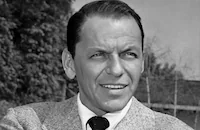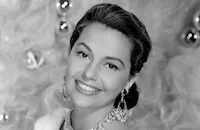The Kissing Bandit

Brief Synopsis
Cast & Crew
Laslo Benedek
Frank Sinatra
Kathryn Grayson
J. Carrol Naish
Mildred Natwick
Mikhail Rasumny
Film Details
Technical Specs

Synopsis
In 1830, when California was a colony of Spain, Chico, an innkeeper and former cohort of the fugitive outlaw known as the Kissing Bandit, learns that the bandit's son Ricardo will be visiting from Boston. In a letter to Chico, Ricardo has written that he has been attending college and intends to help Chico with his "business," but Chico misinterprets the letter and believes that the young man is coming to help him return to banditry. Chico and many of his pals eagerly await the arrival of Ricardo, whom they expect will be as brave and cunning as his father, but their excitement soon turns to disappointment when Ricardo approaches them too quickly, loses control of his horse and crashes through the window of Chico's inn. Ricardo, who knows nothing of his father's criminal legacy and has been told that Chico was a former associate of his father's, faints when Chico tells him the truth. Ricardo balks at Chico's expectation that he will become the new bandit chief, and instead insists that he has come to California to help Chico operate his inn. Determined to make a bandit leader out of Ricardo, Chico disregards Ricardo's objections and dresses the young man in his father's clothes. Although Ricardo proves that he is worthless as a holdup man during the first attempt to lead a stagecoach robbery, the other bandits decide to keep him in the gang and use him to distract the women they are robbing with kisses. During the robbery of a stagecoach carrying Teresa, the daughter of Governor Don Jose, Ricardo, stricken by the young woman's beauty, is unable to leave her with a cheap kiss. Teresa returns home dejected, and mistakenly concludes that she was not kissed because the bandit found her unattractive. In love with Teresa, Ricardo later serenades her, but as soon as he finishes singing, he is shot at by Don Jose's guards and forced to flee. Don Jose, who believes that the Kissing Bandit insulted his daughter by refusing to kiss her, orders the arrest of the young trespasser and sends Colonel Gomez to find him. Later, Spanish tax collectors Count Ricardo Belmonte and General Felipe Torro, who are en route to the governor's hacienda, rent a room at Chico's inn. When Belmonte catches Chico stealing money from the sleeping Torro, a fistfight ensues. After subduing Belmonte and tying both tax collectors to their beds, Chico and Ricardo discover that the men are important officials and that they are carrying a letter of introduction to Don Jose. Ricardo and Chico steal the letter and disguise themselves as the tax collectors to gain entry to the governor's hacienda. At Don Jose's hacienda, Ricardo resumes his romantic pursuit of Teresa, and Chico begins romancing Isabella, the governor's sister. While Chico and Ricardo continue to deceive the governor at a fiesta held in honor of the visiting tax collectors, the real tax collectors escape from Chico's inn and make their way to the governor's. By the time they arrive there, however, Chico and Ricardo have revealed their true identities to Don Jose and have won his friendship. After sending Torro and Belmonte back to Spain, the governor asks Ricardo to stay at the hacienda and gives his blessing to their romance.

Director

Laslo Benedek
Cast

Frank Sinatra

Kathryn Grayson

J. Carrol Naish

Mildred Natwick
Mikhail Rasumny

Billy Gilbert
Sono Osato

Clinton Sundberg
Carleton G. Young
Edna Skinner
Vicente Gomez

Ricardo Montalban

Ann Miller

Cyd Charisse
Henry Mirelez
Nick Thompson
Joe Dominguez
Albert Morin
Michael Kostrick
Fred Gilman
Pedro Regas
Leo Mostovoy
Gero Maly
Wilson Wood
Margaret Martin
Carl Pitti
Captain Garcia
Carlos Albert
Julian Rivero
Mitchell Lewis

Byron Foulger
Jack Manolas
Linda Howard
Nora Christy
Norma Gentner
Ginny Jackson
Susan Hoyt

Nana Bryant
Alex Montoya
Suzanne Ridgway
Crew
Robert Alton
Leo Arnaud
Bob Bain
Earl Brent
Wilhelm Brockway
Nacio Herb Brown
Jack Dawn
Stanley Donen
Randall Duell
Cedric Gibbons
A. Arnold Gillespie
Sydney Guilaroff
John Briard Harding
Edward Heyman
Albert Hunter
Henri Jaffa
Natalie Kalmus
William Katz
Al Lane
Isobel Lennart
Jack D. Moore
Joe Pasternak
Sergei Petschnikoff
Walter Plunkett
Douglas Shearer
J. Frank Shugrue
Georgie Stoll
Marvin Stuart
Robert Surtees
Florence Swann
Edwin B. Willis

Photo Collections
Videos
Movie Clip



Trailer
Hosted Intro
Film Details
Technical Specs

Articles
The Kissing Bandit
At the time it was made, Sinatra had not yet established himself as a major movie star at MGM and was eager to take on any roles he was offered. According to author Michael Freedland in All the Way: A Biography of Frank Sinatra, the film was "a story of a young businessman in the nineteenth century who is a little too conscious of his family responsibilities: his father had a reputation both as a criminal and a great lover. It was his duty to try to emulate the old man. As the dancer Ann Miller described the film: "It was just horrendous." Freeland also wrote that "Kathryn Grayson remembers that they all knew how bad it was while they were making the movie. 'We used to joke, "What are we going to do for the sequel"?
But some good came out of the experience. According to Freedland, "Sinatra bumped into a producer named Howard Koch. 'I'd like to work with you one day,' Frank told him. Before long, they would work together and Mr. Koch would play a very important part indeed in the Sinatra story, when he became his 'resident' film producer." Also fortuitous was MGM's decision to follow The Kissing Bandit with two much more highly regarded musicals pairing Sinatra with Gene Kelly - Take Me Out to the Ballgame (1949) and On the Town (1949).
All things considered, The Kissing Bandit is far from being the downtrodden outcast it's unfairly remembered for. In fact, the movie, while admittedly not a screen masterpiece, is certainly quite enjoyable, and in addition to the lead's considerable candle power, has much going for it. Anchors Aweigh (1945) co-star Kathryn Grayson works well with Frank, and the opulent Joe Pasternak production is nicely peppered by an array of beloved scene stealers like J. Carrol Naish, Billy Gilbert and Byron Foulger, as well as surprise guest stars Ann Miller, Ricardo Montalban and Cyd Charisse.
The lively Nacio Herb Brown songs keep things moving along in this Western parody breezily directed by Laszlo Benedek. Ironically, it is at "lowly" Columbia, not MGM, that Sinatra and Benedek would, within a few short years, both achieve legendary status - Frank with his landmark portrayal in From Here to Eternity (1953) and Benedek helming the iconic Marlon Brando Fifties epic, The Wild One (1954).
Director: Laszlo Benedek
Producer: Joe Pasternak
Screenplay: John Briard Harding, Isobel Lennart
Cinematography: Robert Surtees
Editor: Adrienne Fazan
Music: Earl K. Brent, Nacio Herb Brown, Edward Heyman
Cast: Frank Sinatra (Ricardo), Kathryn Grayson (Teresa), J. Carrol Naish (Chico), Mildred Natwick (Isabella), Mikhail Rasumny (Don Jose), Billy Gilbert (General Toro).
C-101m. Closed captioning.
by Mel Neuhaus

The Kissing Bandit
Quotes
Trivia
Notes
According to an August 1944 Hollywood Reporter news item, this film was to mark the screen debut of soprano Marion Bell, who was set for the leading female role. In December 1944, another Hollywood Reporter news item announced that Frank Morgan and Lina Romay would appear in major roles. Although Hollywood Reporter news items in April and late August 1945 listed John Carroll in the title role, an early August 1945 Hollywood Reporter news item listed Morgan, Romay, Bell and John Hodiak in the top spots. The starring lineup was changed again in May 1946, when Hollywood Reporter announced that Kathryn Grayson and Tony Martin were assigned the leads. Martin was later replaced by Frank Sinatra. In January 1947, a Hollywood Reporter news item noted that Robert Z. Leonard was set to direct, but he did not participate in the final film. A Hollywood Reporter news item notes that portions of the film were shot on location in Sonora, CA.
The Kissing Bandit marked the first feature film directed by Hungarian-born Laslo Benedek, although he previously had directed retakes for the 1944 M-G-M film Song of Russia (see below). According to mdoern sources, Albert Sendrey provided some of the film's orchestrations. Subsequent to the release of The Kissing Bandit, the film became jokingly known as one of M-G-M's biggest "flops" and an acknowledged lowpoint in the careers of Sinatra and Grayson.

Miscellaneous Notes
Released in United States Winter January 1949
Released in United States Winter January 1949















